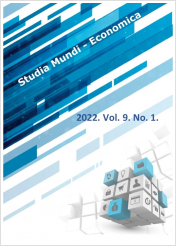EXAMINING THE POTENTIAL FOR SUSTAINABLE DEVELOPMENT OF RURAL AREAS, WITH PARTICULAR REFERENCE TO THE USE OF INDUSTRIAL HEMP
DOI:
https://doi.org/10.18531/Studia.Mundi.2022.09.01.35-44Keywords:
vidékfejlesztés, fenntarthatóság, regionális gazdaság, ipari kendertermesztésAbstract
In recent years, the cyclical changes that have shaped our lives have inevitably confronted society with externalities that have restructured our health, our environment and our welfare. During the pandemic period, most members of society have valued their health and the importance of a liveable environment, the importance of a lifestyle with typical rural characteristics, and the development of liveable spaces, including the exploitation of alternative, sustainable architectural options. It is important to note that the triad of nature, society and economy can be defined as the basis for integrated rural development, where nature is set within society and within it the economy. Consequently, the natural dimension should be at the forefront of all the activities that influence economic processes. By respecting these rules, it is possible to create sustainable living communities. In order to create a healthy living environment, it is necessary to minimise negative ecological impacts and improve environmental conditions, applying the precautionary principle, which is also included in the objectives of sustainable urban management.
Thanks to our climatic and ecological conditions, the possibility of economically growing and exploiting industrial hemp has been available in our country for centuries. However, in the first third of the 20th century, both at global and domestic level, the progress and technological development of the 'hemp economy' was made impossible by law, so that the cultivation and processing of this crop is lagging far behind the agricultural technology of today. Today, however, the revival and revitalisation of the industrial hemp industry seems to be taking place in a growing number of countries. In our study, we set out to investigate this direction of development.
References
Csatári, B. (2001). A vidék földrajzi kérdései. Szeged: Földrajzi Konferencia.
Dudics, K. (2013). Ökológikus építészet felé- Mit tanulhat az építészet az ökológiától- és mit tehet érte? Budapest Műszaki és Gazdaságtudományi Egyetem: Budapest.
Fleischer, T. (2014). A fenntarthatóság fogalmáról. In I. Bukovics, T. Fleischer, L. Kátai-Urbán, G. Németh, G. Németh, T. Réti, és mtsai., Közszolgálat és fenntarthatóság (old.: 9-24). Budapest: Nemzeti Közszolgálati Egyetem.
Káposzta, J., Honvári, P. (2019). A smart falu koncepciójának főbb összefüggései és kapcsolódása a hazai vidékgazdaság fejlesztési stratégiájához. Tér és társadalom , 33 (1), 83-97. DOI: https://doi.org/10.17649/tet.33.1.3091
Kis, K. (2007). A biomassza energetikai hasznosításának helye és szerepe a vidékgazdaságban. Agrár- és Vidékfejlesztési Szemle , 55-61.
Kis, K. (2014). Vidékgazdaság, kultúra, lokalizáció: eltérő válaszok és fejlődési differenciák. Jelenkori társadalmi és gazdasági folyamatok, 9-28.
Lányi, E. (2009). Fenntartható és energiatudatos építés. Energiagazdálkodás , old.: 22-25.
Lányi, E. (2010). Környezettudatos épített környezet- A modellváltás elvei és építészeti eszközei. Budapest: Budapest Műszaki és Gazdaságtudományi Egyetem, Építészmérnöki Kar, Épületszerkezettani tanszék.
Lengyel, I. (2010). A regionális tudomány "térnyerése": Reális esélyek avagy csalfa délibábok? Tér és társadalom , 24 (3), 11-40. DOI: https://doi.org/10.17649/tet.24.3.1326
Meadows, Randers, J., H, D., Meadows, D. L. (1972). The limits of growth. Universe Books: New York.
Meggyesi, T. (2006). Településfejlesztés. Budapest.
Milávics, G., Ván, H. (2008). Az ökológiai fenntarthatóság és regionális versenyképesség összefüggései. Tér és társadalom , 22 (2), 21-40. DOI: https://doi.org/10.17649/tet.22.2.1168
Szlávik, J. (2005). Fenntartható környezet és erőforrás gazdálkodás. KJK-Kerszöv: Budapest.
Az ipari kender ágazatának stratégiai területei. NSKI, 2020.
Venczel, Márk, Peredy, Zoltán, Rohács, Dániel, Rohács, József (2019): Intelligens biztonsági megoldások a nemzetközi repülőterek jövőbeli terrorfenyegetettségének hatékony csökkentése érdekében. REPÜLÉSTUDOMÁNYI KÖZLEMÉNYEK (1997-TŐL) 31: 3 pp. 187-204, 18 p. (2019) DOI: https://doi.org/10.32560/rk.2019.3.631
Downloads
Published
Issue
Section
License
Copyright (c) 2022 Kapás György Ádám, Lőrinc Balázs, Káposzta József

This work is licensed under a Creative Commons Attribution-NonCommercial-NoDerivatives 4.0 International License.
A folyóirat Open Access (Gold). Cikkeire a Creative Commons 4.0 standard licenc alábbi típusa vonatkozik: CC-BY-NC-ND-4.0. Ennek értelmében a mű szabadon másolható, terjeszthető, bemutatható és előadható, azonban nem használható fel kereskedelmi célokra (NC), továbbá nem módosítható és nem készíthető belőle átdolgozás, származékos mű (ND). A licenc alapján a szerző vagy a jogosult által meghatározott módon fel kell tüntetni a szerző nevét és a szerzői mű címét (BY).






